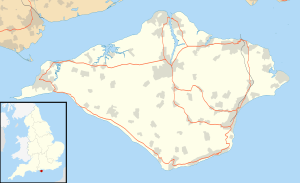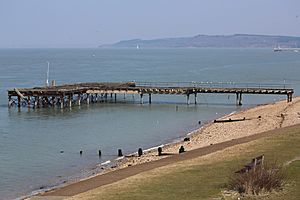Fort Victoria (Isle of Wight) facts for kids
Quick facts for kids Fort Victoria |
|
|---|---|
| Isle of Wight, England | |

Fort Victoria's casemates. The brickwork in the foreground shows the foundations of the former barracks.
|
|
| Coordinates | 50°42′24″N 1°31′16″W / 50.706667°N 1.521111°W |
| Type | Palmerston Fort |
| Site information | |
| Owner | Isle of Wight Council |
| Site history | |
| Built | 1850s |
| Materials | Brick, concrete |
Fort Victoria is an old military fort found on the Isle of Wight in England. It was built to protect the Solent, which is a strait of water. The very first fort here was called Sharpenode Bulwark. It was built between 1545 and 1547 by Henry VIII. However, these early defenses fell apart by the 1600s.
The current Fort Victoria was constructed in the 1850s. It was made of brick and shaped like a triangle. It had two parts facing the sea that met at a right angle. The fort was used by the military until 1962. Later, some parts of the fort were taken down. What is left now is part of the Fort Victoria Country Park.
Contents
Where is Fort Victoria?
Fort Victoria is located on Sconce Point. This is just west of Yarmouth. From its spot, the fort can see the entire Needles Passage. It also overlooks the ways into Yarmouth. It is almost directly across the water from Hurst Castle on the mainland. About one kilometer to the southwest is another fort called Fort Albert.
Earlier Forts on the Site
The very first fort on this spot was called Sharpenode Bulwark. It was built between 1545 and 1547. This was part of Henry VIII's plan to protect the coast. It was about 700 meters east of an even older building called Worsley's Tower.
Sharpenode Bulwark was a square earthwork. It had two corner strongholds. Over time, it fell into disrepair. It was fixed or even replaced in 1587 by George Carey. He was the Captain of the Island at the time. This new version became known as Carey's Sconce. By 1623, these defenses were also in bad shape. By the early 1800s, only ruins were left.
Building Fort Victoria
Fort Victoria was built in the 1850s. It was made of brick with concrete floors for guns. It had two parts facing the sea that met at a right angle. It became an important part of the new gun batteries built on the hills above.
At the same time, a pier was built to help the fort. The fort became a place for soldiers to live and for storing supplies. In the 1880s, it was given more modern weapons. During the First World War and Second World War, the fort was used as a landing spot and for storage. Between the wars, it was not used much. The royal engineers left in 1920.
In the 1930s, there was an idea to start a car ferry service. This ferry would run between Fort Victoria and Keyhaven on the mainland. A special law was passed in 1936 to allow this. But there wasn't enough money, so the plan was stopped in 1938.
At the start of World War II, the fort was used to train coastal gunners. It was also fitted with torpedo tubes on the pier. After the war, it was used as a training station for National Service. This was a time when young men had to join the military. The fort's military use ended in 1962.
Today, only a part of the fort remains. The back buildings where soldiers lived were torn down in 1969. Their materials were used to build sea defenses. The Isle of Wight Council bought what was left of the fort soon after. Fort Victoria is now a Grade II Listed Building. This means it is an important historical site.
Fort Victoria Country Park
Today, the fort is part of Fort Victoria Country Park. This park covers 20 hectares of woodland and shore. It is located on the northwest coast of the Isle of Wight. The fort itself now has several fun attractions. These include a Reptilarium, a Visitor Centre, a planetarium, and a model railway.
You can still see the old, unused pier today.



